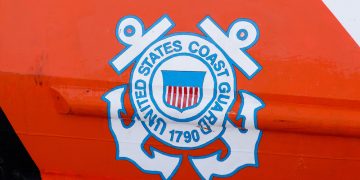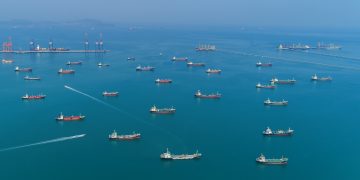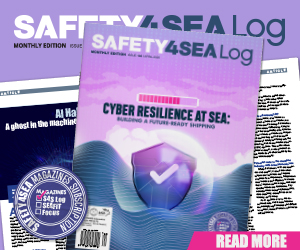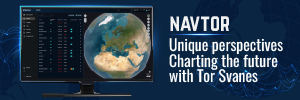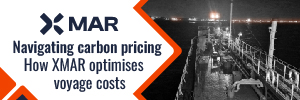During the 2025 GREEN4SEA Athens Forum, Dimitris Mytilinis, Senior Performance Engineer, Latsco Marine Management Inc. delivered an insightful presentation on the evolving landscape of shipping decarbonization. He also tackled various regulatory frameworks, especially focusing on how measures such as pooling can assist in compliance under the FuelEU Maritime.
Overview of FuelEU Maritime Regulation
The FuelEU Maritime Regulation aims to reduce greenhouse gas (GHG) intensity from MRV voyages. This objective can be met through the use of alternative fuels, including LNG, LPG, biofuels, and renewable fuels of non-biological origin. Shore-side electricity and wind-assisted propulsion also support compliance under this regulation.
The regulation monitors three types of GHG emissions:
- carbon dioxide (already monitored under CII and EU ETS),
- methane,
- and nitrous oxide.
It adopts a well-to-wake approach and sets a GHG intensity limit that decreases every five years. Each year, the actual GHG intensity is measured and compared to the regulatory limit. The difference between the two is multiplied by the energy used during the year to determine the compliance balance, which may be either a surplus or a deficit.
Compliance options
There are four primary compliance options under the regulation:
- Banking: Surplus compliance can be carried forward to future years.
- Borrowing: Deficits may be covered by borrowing from future compliance periods, subject to a 10% premium.
- Penalty: A financial penalty may be paid in cases of non-compliance. The penalty amount is calculated using a regulatory formula. If a vessel is penalized for two or more consecutive years, an additional 10% escalation applies annually.
- Pooling: Vessels may participate in pooling arrangements to share compliance balances. Pools can be organized within a single company or between multiple companies.
In single-company pools, the participating company retains full control over the compliance balance and is responsible for registering the compliance data and appointing a verifier in the FuelEU database.
In multi-company pools, each company will remain responsible for registering pool details (compliance allocation and verifier) in the FuelEU database. Effective cooperation is essential in these cases.
Pooling scenarios
The visual chart below presents three pooling scenarios involving three vessels: two with deficits (-50 and -20) and one with a surplus (+100). All scenarios are acceptable provided the total pool balance remains positive.

Vessels entering the pool with a surplus must retain that surplus, and no vessel may participate in more than one pool.
New digital platforms now enable companies to form and join multiple pools, allowing greater flexibility in sharing compliance balances.
Implementation timeline
FuelEU was adopted by the European Parliament in 2023. By August of last year, monitoring plans were required to be submitted to verifiers. The regulation is currently in force. By January next year, shipping companies must submit data regarding fuel consumption for the year 2025.
By the end of March 2026, verifiers must complete the verification and by April 2026, shipping companies must select their chosen compliance method. By the end of June, each vessel will receive a document of compliance.
Comparison with other regulations
FuelEU is considered stricter than CII and EU ETS due to its broader emissions scope and well-to-wake methodology. Compliance requirements are also more rigorous, particularly with respect to fuel types. Biofuels are advantageous across all regulatory frameworks.
Case study: LR2 tanker voyage
We have a real case scenario with two typical voyages for an LR2 tanker. The voyages are between European Union and non-European Union ports.

In the first case, we have conventional fuel. We see we have a deficit. We have a fuel penalty to be paid and EU ETS allowances. If the same voyages had been performed using biofuel, B24, in that case, the compliance balance would have been positive, and the surplus fuel penalty, almost 800, could be used for a pool. It could be the money that the shipping company can gain by participating in a pool and sharing this compliance balance.
Of course, the EU ETS allowances are less, but we have a premium to be paid due to the cost increase of the biofuel. Overall, we see a huge benefit for the biofuel instead of conventional fuels.
These calculations are performed daily within a shipping company. So, there is a need to have smart tools to calculate and have immediate estimation about environmental impact.
Special considerations for LNG
Finally, I would like to share some insights about LNG due to its particularities. LNG contains nitrogen, and nitrogen can be deducted across all these regulations. Therefore, it’s important to have a way to calculate this nitrogen in order to exclude it.
In addition, methane slip can also be calculated for the MRV regulation. Methane slip can be calculated based on specific formulas available per engine. But there are also advanced sensors that can be used to calculate the methane slip. These sensors can be fitted on an engine on a vessel.
The views presented are only those of the authors and do not necessarily reflect those of SAFETY4SEA and are for information sharing and discussion purposes only.
Above article has been edited from Dimitris Mytilinis’ presentation during the 2025 GREEN4SEA Athens Forum.
Explore more by watching his video presentation here below
























